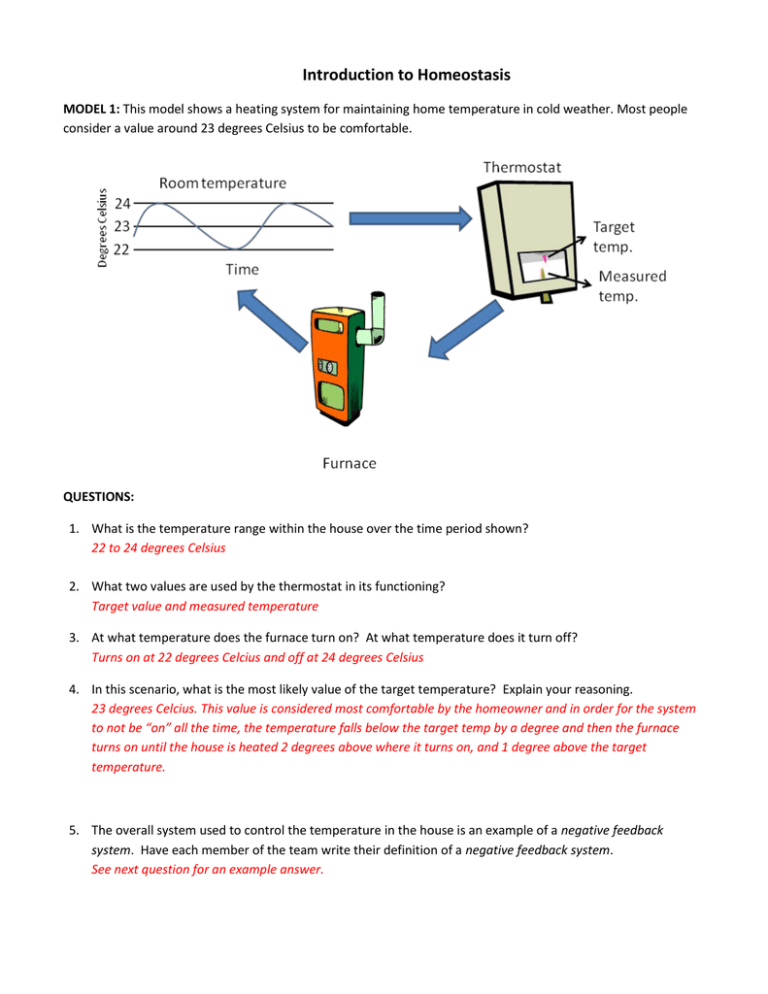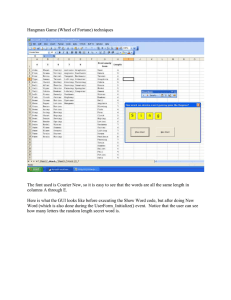Homeostasis & Feedback Loops Worksheet
advertisement

Introduction to Homeostasis MODEL 1: This model shows a heating system for maintaining home temperature in cold weather. Most people consider a value around 23 degrees Celsius to be comfortable. QUESTIONS: 1. What is the temperature range within the house over the time period shown? 22 to 24 degrees Celsius 2. What two values are used by the thermostat in its functioning? Target value and measured temperature 3. At what temperature does the furnace turn on? At what temperature does it turn off? Turns on at 22 degrees Celcius and off at 24 degrees Celsius 4. In this scenario, what is the most likely value of the target temperature? Explain your reasoning. 23 degrees Celcius. This value is considered most comfortable by the homeowner and in order for the system to not be “on” all the time, the temperature falls below the target temp by a degree and then the furnace turns on until the house is heated 2 degrees above where it turns on, and 1 degree above the target temperature. 5. The overall system used to control the temperature in the house is an example of a negative feedback system. Have each member of the team write their definition of a negative feedback system. See next question for an example answer. 6. Using a grammatically correct sentence, write your best team definition for a negative feedback system. A negative feedback system is a system used to control a variable by instituting a process that counteracts a change from the target setting, bringing the value of the variable back toward the target. 7. The homeowner has Northern Australian orchids growing in the house, which only grow in temperatures above 22 degrees Celsius. If the thermostat or the wire from the thermostat to the furnace breaks, what will happen to the temperature in the house? What will happen to the orchids? Because this system is meant to keep the house “warm”, the house will cool. This will either kill the Orchids or keep them from growing. 8. In the summer, how could this loop be modified (settings or components) to keep the house around the same target temperature? The furnace could be replaced with an air conditioner (or an air conditioner could just be added in) that the thermostat communicates with. MODEL 2: Negative Feedback Loop Homeostasis is an important ability associated with living organisms. It is typically carried out through a process using a negative feedback loop, similar to the loop that controls the temperature in a house. Figure 2A shows the generic components of the loop, and Figure 2B shows an example loop important in maintaining blood pressure. Figure 2A: General Homeostatic Feedback Loop Figure 2B: Homeostatic Feedback Loop for the Regulation of Blood Pressure QUESTIONS (Refer to Models 1 and 2): 9. List the 3 components that you would expect to find in any feedback loop. Refer back to Model 1 and indicate which item from Model 1 represents each component. Then refer back to Model 2, Figure 2B, and indicate which item from Figure 2B represents each component. Components of a feedback loop Items from Model 1 that are representative of each component Items from Model 2, Figure 2B that are representative of each component Sensor Thermostat Pressure receptors (baroreceptors) Integrator Thermostat Brainstem nuclei Effector(s) Furnace Heart rate (heart) Force of contraction of heart Constriction of blood vessels 10. Besides the main components of the loop (listed in question 9), what other feature is important in the functioning of a feedback loop? The ability of the components to communicate with each other. 11. Is the goal of a negative feedback loop to maintain a regulated variable at a constant value? Explain. Not necessarily constant, but within a suitable range around a set point or target value. 12. Is a negative feedback loop limited to one effector? Explain. No, in the control of blood pressure there are multiple effectors, such as responses by both heart and blood vessels. 13. Do you think the integrator always a separate anatomical structure from the sensor? Explain. No, it is often the same structure, similar to a thermostat being both the sensor an integrator. Teachers note: An example of this would be in the regulation of plasma glucose levels. Cells of the pancreas act a both the sensor and integrator. 14. The ability to maintain homeostasis is considered critical to the normal functioning of life and is normally carried out through the use of a negative feedback loop. Individually write your best definition of homeostasis. See answer to next question 15. As a team, write your best definition of homeostasis. Answers will vary, but a good definition is “the body’s ability to maintain certain variables in a range suitable for life”. In your discussion, please point out that we may not all have exactly the same set point and that it is hard to keep us at a “constant” value for just about anything. But the system works well at using a setpoint as a target to keep the variables in a suitable range. Extension Questions 16. Is heart rate a homeostatically-controlled variable? Explain. No, although most individuals have a HR that falls within a specific range (such as 50 to 150), it is actually an effector for regulating blood pressure. There is no receptor for measuring HR. 17. What happens when a homeostatically-controlled feedback loop is damaged or interrupted? If possible, provide a specific example. Answers may vary, but it is likely that damage or disease will ccur because the regulated variable is likely to end up outside of the appropriate range. a. Body temperatures. If we are too hot or too cold, we tend to feel ill or die. b. Blood pressure. Hypotension (too low) makes us feel dizzy. Too high and it damages blood vessels, kidneys, etc. c. Plasma glucose. Too low and we can feel dizzy and pass out. Too high and it can make us lose water in our urine and cause longer-term damage to blood vessels and nerves. 18. Based on your current knowledge, sketch a feedback loop for the control of temperature in the body. Be as specific as possible with the structures involved. An example loop might be: 19. Predict what would change in this feedback loop when someone is experiencing a fever. The set point (target value) in the hypothalamus changes to a higher temperature value. The rest of the loop stays the same.
